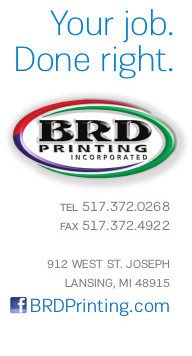Types of Printing
4-Color Process (CMYK)
Also referred to as full-color printing, 4-color process printing combines cyan, magenta, yellow, and black inks (CMYK) to produce a wide spectrum of color. This is the most common type of printing, as it allows for a range of colors and tones that is ideal for photographic images or multi-colored designs and logos.
Spot Color
Spot colors, or PMS (Pantone Matching System) colors, refer to ink that has been specifically mixed to match a universal standard of color. Spot printing is ideal for branding and logos that require color accuracy, as a printer can match ink with extreme accuracy to the desired result.
Metallic Ink
Some inks use fine metallic particles such as copper, bronze, zinc or aluminum to give them shine and luster not seen in standard inks. They come in a variety of colors, most commonly gold and silver, but it’s not uncommon to see blues, reds and coppers as well.
Foil Stamping
If you want an even bolder look, foil stamping may be the way to go. The process uses pressure and a heated die to fuse the foil to the surface of a sheet of paper. Foil stamping is a great way to draw attention and elevate your project.
Embossing
Are you looking for a 3-dimensional effect? Embossing uses a heated metal die to raise a design above the surface of the paper. Embossing can be used on its own (blind embossing) or in combination with inks or foils.
Die Cutting
Die cutting allows you to create unconventional shapes for your design. A razor-sharp blade is formed into a pattern, or “die,” that cuts the paper into any shape, from perfect circles to the outline of a logo or image.
Types of Printing
4-Color Process (CMYK)
Also referred to as full-color printing, 4-color process printing combines cyan, magenta, yellow, and black inks (CMYK) to produce a wide spectrum of color. This is the most common type of printing, as it allows for a range of colors and tones that is ideal for photographic images or multi-colored designs and logos.
Spot Color
Spot colors, or PMS (Pantone Matching System) colors, refer to ink that has been specifically mixed to match a universal standard of color. Spot printing is ideal for branding and logos that require color accuracy, as a printer can match ink with extreme accuracy to the desired result.
Metallic Ink
Some inks use fine metallic particles such as copper, bronze, zinc or aluminum to give them shine and luster not seen in standard inks. They come in a variety of colors, most commonly gold and silver, but it’s not uncommon to see blues, reds and coppers as well.
Foil Stamping
If you want an even bolder look, foil stamping may be the way to go. The process uses pressure and a heated die to fuse the foil to the surface of a sheet of paper. Foil stamping is a great way to draw attention and elevate your project.
Embossing
Are you looking for a 3-dimensional effect? Embossing uses a heated metal die to raise a design above the surface of the paper. Embossing can be used on its own (blind embossing) or in combination with inks or foils.
Die Cutting
Die cutting allows you to create unconventional shapes for your design. A razor-sharp blade is formed into a pattern, or “die,” that cuts the paper into any shape, from perfect circles to the outline of a logo or image.
Types of Printing
4-Color Process (CMYK)
Also referred to as full-color printing, 4-color process printing combines cyan, magenta, yellow, and black inks (CMYK) to produce a wide spectrum of color. This is the most common type of printing, as it allows for a range of colors and tones that is ideal for photographic images or multi-colored designs and logos.
Spot Color
Spot colors, or PMS (Pantone Matching System) colors, refer to ink that has been specifically mixed to match a universal standard of color. Spot printing is ideal for branding and logos that require color accuracy, as a printer can match ink with extreme accuracy to the desired result.
Metallic Ink
Some inks use fine metallic particles such as copper, bronze, zinc or aluminum to give them shine and luster not seen in standard inks. They come in a variety of colors, most commonly gold and silver, but it’s not uncommon to see blues, reds and coppers as well.
Foil Stamping
If you want an even bolder look, foil stamping may be the way to go. The process uses pressure and a heated die to fuse the foil to the surface of a sheet of paper. Foil stamping is a great way to draw attention and elevate your project.
Embossing
Are you looking for a 3-dimensional effect? Embossing uses a heated metal die to raise a design above the surface of the paper. Embossing can be used on its own (blind embossing) or in combination with inks or foils.
Die Cutting
Die cutting allows you to create unconventional shapes for your design. A razor-sharp blade is formed into a pattern, or “die,” that cuts the paper into any shape, from perfect circles to the outline of a logo or image.

